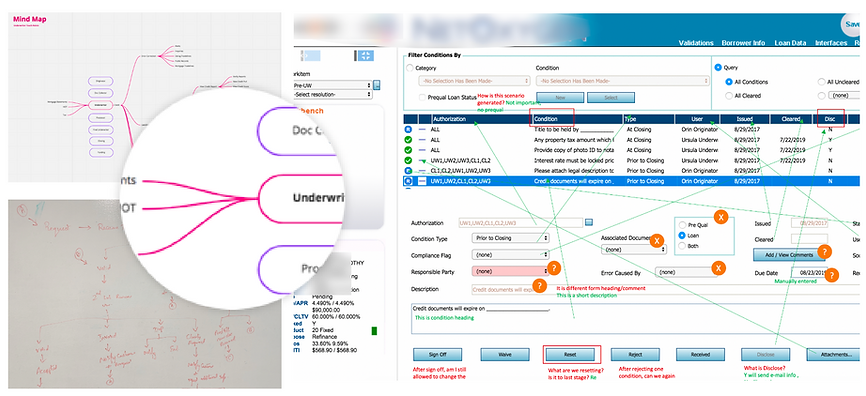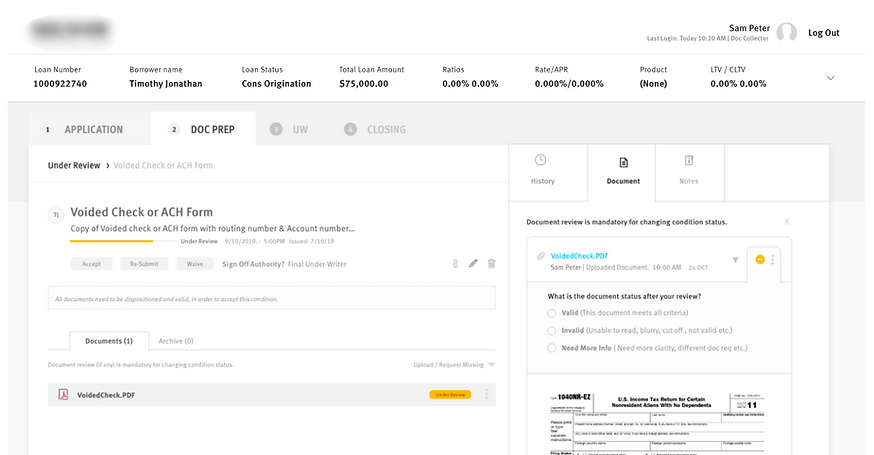
Experience Design
I came on board to address the user experience of a key loan verification agent portal. This system is vital for backend agents, who use it to manage borrower document submissions and updates.
The context for this project was clear: an established portal, used habitually by agents for years, yet built without any foundational user experience principles. Since joining, I've been dedicated to delivering continuous UX improvements to transform this critical platform.

Guided Process
Creating a single screen featuring a guided process for each type of work

Automations
Continue automating steps and activities wherever possible

Task Oriented
Enabling each role with standard value added tasks

Standardized Approach
Create more structured and standardized approach. Break agent work process in to smaller tasks
Goal: Scale our business in the next few years
Reduce agent training costs by making the portal more user-friendly, so that it is self explanatory for new users, and expedite loan approval was a top priority when we began this project.
Our focus was to provide a solution that can be re-used for all user groups, for this we created different brainstorm sessions with the business groups.
Value Stream Mapping


Waste Analysis
Post mapping of the current process steps in the right sequence, we evaluated the process to identify if the steps added value to the customer.
Any steps did not add value were considered a waste (e.g. having to navigate to ‘Conditions’ screen post review of document to mark related condition as ‘Received’ is considered a waste)
Throughout this phase, we conducted brainstorming & research sessions, leveraging participatory design methods. This approach was necessary to understand the process for different user groups.

Journey Mapping
While our long-term goal was to entirely reframe the system, we adopted an iterative approach, beginning with a single feature for a targeted user group. This strategy allowed us to deeply focus on incorporating all valuable user elements.
Despite facing numerous unforeseen obstacles that affected our design schedule, we prioritized a core objective: layout optimization. Our research underscored the critical need for a user-friendly design that speaks for itself, demonstrating the portal's inherent value. Recognizing the significant time investment required for a complete end-to-end solution, this focused effort enables us to effectively demonstrate our capabilities to a wider group.

Ideation, Architecture
Although the existing Portal houses all required elements, there are opportunities to streamline and improve the user/agent experience for ease.
To overcome existing biases, we came up with a design approach that was based on the research we conducted on the online portal and with real-time agents.


Understanding features & Mapping
To gain a clear understanding of the complex approval and sign-off processes, I meticulously mapped out existing workflows. This exercise was crucial in identifying specific pain points our system could alleviate and highlighting key opportunities for innovation and optimization within the portal.


Paper Sketch & Flow
I initiated the project by mapping the intricate approval and sign-off workflows, which was instrumental in uncovering critical pain points within the portal. This analysis also revealed significant opportunities for our system to introduce innovative solutions that would streamline processes and enhance user experience.

Wireframing & Prototyping
To move forward with the design I used hi-end design tools available in the market to create sets of detailed mockups. This approach was beneficial in showing our stakeholders design progress
Our ambitions is to create a strong foundation that embrace a rapidly evolving business and more diverse user base.





Visual design and style guide
From a design perspective, the system needs to effectively cater to a diverse network of users, encompassing borrowers and various agent roles, such as Processors, Document Collectors, Underwriters, and Closers.
Each of these user groups presents unique use cases that require visually rich and intuitive designs, ensuring a superior user experience across the entire application.


